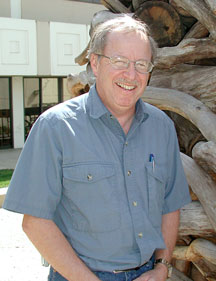

Study Reveals Unusual Structure of Cellular Transport Nanocage
By Eric Sauter
A new study by scientists at The Scripps Research Institute has revealed for the first time the structure of Sec13/31, a "nanocage" that transports a large body of proteins from the endoplasmic reticulum (ER), which makes up more than half the total internal cell membrane, to other regions of the cell.
The newly uncovered structure of the Sec13/31 cage reveals a self-assembling nanocage that to a significant degree helps shape basic human physiology from birth to death, and could one day lead to new treatment approaches to a number of diseases including diabetes and Alzheimer's disease. This new knowledge will allow further study of the structure's function in building and maintaining membranes required for exporting key molecules such as insulin, involved in the onset of diabetes, and beta amyloid, associated with Alzheimer's disease. The new findings were published in the January 12, 2006 (Vol 439) issue of the journal Nature.
"One-third of the proteins encoded by the genome flow through this transport cage," Professor William E. Balch, one of the study leaders, said. "These proteins ultimately control all aspects of cell structure, differentiation, signaling, and proliferation—and when defects occur during transport, the result may be any one of several serious disorders. Expanding our knowledge of this cage structure is fundamental to our understanding of the organization and function of the membrane architecture of every cell in the human body and eukaryotic cells in general. In some ways, this new finding may be as important to the study of the cell as was the discovery of the structure of DNA to understanding the genetic code."
The study was a collaboration between the laboratory of William Balch, a professor in Scripps Research's Department of Cell Biology and Department of Molecular Biology and member of the Institute of Childhood and Neglected Diseases, and the laboratory of Bridget Carragher and Clinton S. Potter, who direct the NCRR National Resource for Automated Molecular Microscopy (NRAMM) based at Scripps Research. NRAMM's mission is aimed at fully automating the process of defining macromolecular structures using cryo-electron microscopy. Carragher and Potter are associate professors in Scripps Research Department of Cell Biology and the Center for Integrative Biosciences (CIMBio).
The endomembranes of eukaryotic cells—cells containing membrane-bound structures such as the nucleus—are in continuous communication with the outside environment through the activity of specialized cellular machines which mediate cargo export from the endoplasmic reticulum. A complex process concentrates these proteins by folding and packaging them for transportation. The proteins are collected in membrane packets that are surrounded by a protein coat or cage and pinched off from the ER.
One of these cellular machines, COPII, consists of a number of smaller protein subunits including Sec13 and Sec31 (Sec13/31), a complex found in the cytoplasm of the cell. Using NRAMM's advanced imaging technologies including automated cryo-electron microscopy and single particle analysis, the researchers showed that Sec13/31 can self-assemble in vitro as a cuboctahedron—a geometric shape composed of six squares and eight triangles that had not been previously observed in biological cages. This unusual but abundant structure encapsulates the budding ER membrane. These findings suggest that the unique structural properties of the Sec13/31 cage may enable it to form highly flexible polyhedrons of increasingly complex geometric shapes that are capable of transporting not only small proteins, but large, oddly shaped molecular cargo such as chylomicron particles involved in cholesterol metabolism, or procollagen involved in bone biogenesis, processes vital to maintaining human function.
"Our results show that the function of Sec13/31 is analogous to that of clathrin, another cellular protein that can also self-assemble in vitro to form transport cages," Balch said. "However, these are strikingly different from the Sec13/31 cage. Our discovery that the self-assembling properties of Sec13/31 produce a unique nanocage structure offers an unprecedented opportunity to study what are most likely novel biological mechanisms underlying cargo selection, concentration and transport of the proteins that pass through this cellular architecture. This may help point the way toward new therapeutic approaches to a variety of diseases."
Type II diabetes, amyloidosis, cystic fibrosis, childhood emphysema, and even cancer are caused by protein folding/packaging defects in the ER that result in either a loss of activity or a protein build up in the cell. One focus of Balch's laboratory has been to understand how these folding defects affect normal protein function within the transport pathway.
"Through our structural knowledge of the nanocage, we hope to gain critical insight into the basis of several inherited transport diseases," Balch said. "With it, we can begin to delve more deeply into the basic functions of these cargo selection and trafficking pathways. From there, we might be able to develop small molecule chemical modulators to encourage export and stability of misfolded proteins which may lead to restoring normal cellular function in these diseases."
The principal authors of the study were Scott M. Stagg, a member of the NRAMM and the Scripps Research Department of Cell Biology, and Cemal Gürkan, of the Scripps Research Departments of Chemistry and Cell Biology. Co-authors included Douglas M. Fowler, Scripps Research Departments of Chemistry and Cell Biology; Paul LaPointe, Scripps Research Department of Cell Biology and; Ted R. Foss, Scripps Research Department of Chemistry. The study was supported by grants from the National Institutes of Health (NIH), an NIH Postdoctoral Fellowship, and a Cystic Fibrosis Foundation Postdoctoral Research Fellowship.
Send comments to: mikaono[at]scripps.edu

"Through our structural knowledge of the nanocage, we hope to gain critical insight into the basis of several inherited transport diseases," says Professor William Balch. Photo by Kevin Fung.
